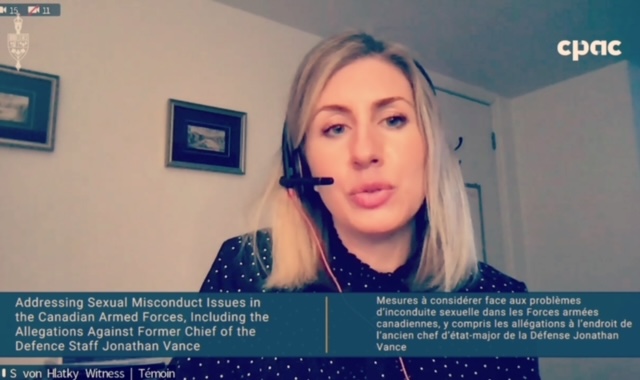This text was originally a statement to the Standing Committee on National Defence on February 26 2021, in the context of the allegations of sexual misconduct against former Chief of Defence Staff Jonathan Vance.
Can a large organization like the Canadian Armed Forces (CAF) transform its culture in five years, guided by an external review, and driven by an order to eradicate sexual misconduct within the ranks? It might seem impossible, but in many ways, the military, as a total organization, might be better suited than most when it comes to adapting quickly in the face of adversity. CAF personnel are trained to make and carry out decisions in complex environments, so why is this reputation for operational excellence not carrying over organizationally? That’s because military culture can have unintended consequences, it can also be gamed by predators and it can be idealized and made to look untouchable by routines, traditions and rigidly hierarchical command structures. At this time, military leaders need to re-engage with the External Review Authority (ERA) report, also known as the Deschamps report, and think more boldly about implementing its recommendations fully. Five years might not be enough time to implement deep transformative cultural change, but it is certainly long enough to uncover the failings of the current approach.
Here are four specific issues that require our attention:
- There should be a greater focus on abuses of power. What I am referring to here is a social dynamic that is interlinked with sexual misconduct in highly asymmetric professional relationships. This kind of implicit or explicit pressure is far more endemic and engrained in the culture than is currently acknowledged. While the Survey on Sexual Misconduct in the Canadian Armed Forces has provided useful data, more is needed to examine how sexual misconduct interacts with consent in asymmetric professional relationships. A woman, or any harassed person, not speaking out against behaviour that is inappropriate does not mean that behaviour is welcome or that she is providing consent. There are many legitimate reasons for going along with these unwelcome interactions and staying silent, many of these reasons are outlined in the Deschamps report. People who are more junior or in more precarious employment conditions fear for their job, they might fear other types of consequences at work, like not being believed by their peers or being socially ostracized for speaking out. Another reason for not coming forward is not trusting the reporting process or not believing that you’ll secure a fair outcome. The next step is to have this more nuanced talk about consent and about consent when power dynamics are at play. Some of those power dynamics are inherent to military culture and some of those dynamics are about rank and translate into abuses of power. Both types of power dynamics disproportionally impact women.
- Training. Op HONOUR training should be improved to pull data from the Stats Can surveys to tailor the content to those receiving the training. The information in the training should be personalized, by making clear that sexual misconduct affects friends and colleagues in the armed forces. Service members should engage and practice difficult scenarios, so they know when to intervene and how. The resentment of (mostly) male service members, who feel they are unfairly targeted by Op Honour, is common and unfortunate. At the same time, the training is too focused on the perpetrator, while it could engage with military culture, militarized masculinity, the under-representation of women, consent, the needs of victims/survivors, empowering bystanders in small, interactive sessions led by someone who can speak in an authentic way about the content. External experts can help in this regard, if only to provide a peer-review function for the training materials.
- The SMRC: One of the most talked about ERA recommendations was that a reporting line outside of the Chain of Command was needed, which prompted the creation of the Sexual Misconduct Response Centre (SMRC) as an independent body. There is an inherent tension in the SMRC’s work because of the nature of its mandate: on the one hand, the SMRC needs to hold the CAF accountable, but it also needs a good working relationship with the CAF, including with the chain of command, which might undermine perceptions of the SMRC’s independence. Constant review and oversight of the SMRC, both through internal self-assessments and external audits, might be needed as the protection of the SMRC’s independence in the face of its growing mandate is paramount.
- The Path to Dignity and Respect. The Path is a promising approach because it puts culture and climate front and centre (thereby making cultural change everyone’s business). But while it makes sense for this document to define culture and climate, along with a series of indicators, it should dedicate more attention to describing the problem at hand: sexual misconduct and how it ties to culture and climate. Basically, the scope of the problem needs to be crystal clear before jumping into the solutions. A journey of culture change needs to convey shared responsibility for sexual misconduct. The percentage of CAF members who have witnessed sexual misconduct is pretty astounding, but how many people intervene, speak up, report? If one does not engage in sexual misconduct, it does not mean you perform your duty with honour. The standard of performance is much higher than that if you want to get to Zero Tolerance. It is the notion of collective responsibility that should be stressed more forcefully throughout the document because EVERYONE can do better on this front. This is not about the duty to report, it is a standard of daily conduct. The challenge moving forward is not simply about how to eradicate sexual misconduct within the military, but entails identifying positive steps to create a culture of equality for women in the CAF and a culture centered around respect for all.





Comments are closed.